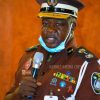Listeners:
Top listeners:
-
play_arrow
Kapital FM 92.9 The Station that Rocks!

On the ground floor of the National Museum of Scotland in Edinburgh, one of its biggest displays is being carefully prepared for a 4,200-mile journey to its original home.
A 36ft (11m), one-tonne totem pole is returning to the Nisga’a Nation, one of the indigenous groups in what is now known as British Columbia on the west coast of Canada.
The totem pole has been in Scotland for almost a century since it was sold to the museum by Canadian anthropologist Marius Barbeau.
However, Nisga’a researchers say it was stolen without consent while locals were away from their villages for the annual hunting season.
Reports say the museum believes it acted in good faith but now understands that the individual who “sold” it to Barbeau did so “without the cultural, spiritual, or political authority to do so on behalf of the Nisga’a Nation”.

Last year it was agreed that the pole should be returned.
The totem pole was carved from red cedar in 1855 and is made almost entirely from a single piece of wood, with a small cap on top which can be separated
It originally stood in Ank’idaa village on the banks of the Nass River before it arrived in Scotland in 1929.
The totem, according to BBC which features carved animals, human figures, and family crests, tells the story of a Nisga’a warrior who was next in line to become chief before his death.
Dr Amy Parent, who is the Canada research chair in indigenous education and governance at Simon Fraser University in Vancouver, has led the move to return the pole.

According to reports, Dr Parent, who has the Nisga’a cultural name Noxs Ts’aawit, said: “Within the pole itself we have crests that are carved – often represented by animals or humans – and within our particular pole there are two carved ravens as well as some other animals and then the chief sitting at the top.
“The ravens themselves represent the name Ts’aawit. He was an ancestral relative who passed away. He had lost his life defending our nation. He was a warrior and part of my name is attached to the name Ts’aawit.”
On Monday, a group of Nisga’a people, including Noxs Ts’aawit (Dr. Parent), will carry out a private spiritual ceremony in front of the pole in Edinburgh before scaffolding is erected and encased in a protective cradle for its epic move.
BBC reported that over the next month, it will be maneuvered out of a museum window and then flown across the Atlantic by the Canadian Air Force.
For the museum, it is a painstaking operation.
Dr John Giblin, keeper of global arts culture, and design at the National Museum of Scotland, said: “To prepare the pole to be able to leave the building we first needed to clear out entire galleries.
“We need to construct a scaffold around the pole, a cradle to have it lowered very carefully and it needs to be moved through the building.
“We need to close a road then it will be moved off to an air base.”
It’s the first time a national museum in the UK has returned a belonging of this type.
“I’m pleased that the pole will be returning to its home where its spiritual, cultural, historical significance is most keenly felt,” Dr Giblin said.
Written by: Elizabeth David
canada KFM929 Pole Return Stolen Totem
Similar posts
Recent Posts
- NHFSS Commissions Office Complex In Idu Abuja
- Mohbad’s Father Confirms Pasting Summons for DNA Test on Daughter-In-Law’s Gate
- Encouraging Creativity, Innovation For National Development
- Environmental Advocate Harps On Proactive Measures To Mitigate Flooding
- Political Parties Urged To Uphold Structures To Check Suspension Of Leaders
Recent Comments
No comments to show.Top popular
Chart
-
-
play_arrow
Sunshine Tommy Blues
-
play_arrow
-
-
play_arrow
Red Frank Lee
-
play_arrow
-
-
play_arrow
Eclipse Donna May
-
play_arrow
-
Copyright Kapital FM 92.9 Abuja - The Station that Rocks!











Post comments (0)